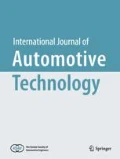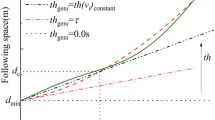Abstract
Electric vehicles with individually controlled drivetrains allow torque-vectoring, which improves vehicle safety and drivability. This paper investigates a new approach to the concurrent control of yaw rate and sideslip angle. The proposed controller is a simple single input single output (SISO) yaw rate controller, in which the reference yaw rate depends on the vehicle handling requirements, and the actual sideslip angle. The sideslip contribution enhances safety, as it provides a corrective action in critical situations, e.g., in case of oversteer during extreme cornering on a low friction surface. The proposed controller is experimentally assessed on an electric vehicle demonstrator along two maneuvers on surfaces with significantly varying tire-road friction coefficient. Different longitudinal locations of the sideslip angle used as control variable are compared during the experiments. Results show that: i) the proposed SISO approach provides significant improvements with respect to the vehicle without torque-vectoring, and the controlled vehicle with a reference yaw rate solely based on the handling requirements for high-friction maneuvering; and ii) the control of the rear axle sideslip angle provides better performance than the control of the sideslip angle at the center of gravity.
Similar content being viewed by others
References
Abe, M., Kano, Y., Suzuki, K., Shibahata, Y. and Furukawa, Y. (2001). Side-slip control to stabilize vehicle lateral motion by direct yaw moment. JSAE Review 22, 4, 413–419.
Baffet, G., Charara, A. and Stephant, J. (2006). Sideslip angle, lateral tire force and road friction estimation in simulations and experiments. IEEE Int. Conf. Control Applications.
De Novellis, L., Sorniotti, A. and Gruber, P. (2015a). Driving modes for designing the cornering response of fully electric vehicles with multiple motors. Mechanical Systems and Signal Processing, 64-65, 1–15.
De Novellis, L., Sorniotti, A., Gruber, P., Orus, J., Fortun, J. M. R., Theunissen, J. and De Smet, J. (2015b). Direct yaw moment control actuated through electric drivetrains and friction brakes: Theoretical design and experimental assessment. Mechatronics, 26, 1–15.
De Novellis, L., Sorniotti, A. and Gruber, P. (2014a). Wheel torque distribution criteria for electric vehicles with torque-vectoring differentials. IEEE Trans. Vehicular Technology 63, 4, 1593–1602.
De Novellis, L., Sorniotti, A., Gruber, P. and Pennycott, A. (2014b). Comparison of feedback control techniques for torque-vectoring control of fully electric vehicles. IEEE Trans. Vehicular Technology 63, 8, 3612–3623.
Di Cairano, S., Tseng, D., Bernardini, H. E. and Bemporad, A. (2013). Vehicle yaw stability control by coordinated active front steering and differential braking in the tire sideslip angles domain. IEEE Trans. Control Systems Technology 21, 4, 1236–1248.
Dizqah, A. M., Lenzo, B., Sorniotti, A., Gruber, P., Fallah, S. and De Smet, J. (2016). A fast and parametric torque distribution strategy for four-wheel-drive energy-efficient electric vehicles. IEEE Trans. Industrial Electronics 63, 7, 4367–4376.
Esmailzadeh, E., Goodarzi, A. and Vossoughi, G. R. (2003). Optimal yaw moment control law for improved vehicle handling. Mechatronics 13, 7, 659–675.
E-VECTOORC (2016). http://www.e-vectoorc.eu
Geng, C., Mostefai, L., Denaï, M. and Hori, Y. (2009). Direct yaw-moment control of an in-wheel-motored electric vehicle based on body slip angle fuzzy observer. IEEE Trans. Industrial Electronics 56, 5, 1411–1419.
Genta, G. (1997). Motor Vehicle Dynamics: Modeling and Simulation. World Scientific. Singapore.
Graber, J. (1997). Driving Stability Controller with Coefficient of Friction Dependent Limitation of the Reference Yaw Rate. U.S. Patent No. 5,671,143.
Hahn, J. O., Rajamani, R. and Alexander, L. (2002). GPSbased real-time identification of tire-road friction coefficient. IEEE Trans. Control System Technology 18, 3, 331–343.
Her, H., Koh, Y., Joa, E., Yi, K. and Kim, K. (2016). An integrated control of differential braking, front/rear traction, and active roll moment for limit handling performance. IEEE Trans. Vehicular Technology 65, 6, 4288–4300.
Hsu, Y. J., Laws, S. M. and Gerdes, J. C. (2010). Estimation of tire slip angle and friction limits using steering torque. IEEE Trans. Control System Technology 18, 4, 896–907.
Kaiser, G. (2014). Torque Vectoring -Linear Parametervarying Control for an Electric Vehicle. Ph. D. Dissertation. Hamburg University of Technology. Hamburg, Germany.
Kim, C. S., Hahn, J. O., Hong, K. S. and Yoo, W. S. (2015). Estimation of tire-road friction based on onboard 6-DoF acceleration measurement. IEEE Trans. Vehicular Technology 64, 8, 3368–3377.
Liu, C. S. and Peng, H. (1996). Road friction coefficient estimation for vehicle path prediction. Vehicle System Dynamics 25, S1, 413–425.
Lu, Q., Gentile, P., Tota, A., Sorniotti, A., Gruber, P., Costamagna, F. and De Smet, J. (2016a). Enhancing vehicle cornering limit through sideslip and yaw rate control. Mechanical Systems and Signal Processing, 75, 455–472.
Lu, Q., Sorniotti, A., Gruber, P., Theunissen, J. and De Smet, J. (2016b). H8 loop shaping for the torquevectoring control of electric vehicles: Theoretical design and experimental assessment. Mechatronics, 35, 32–43.
Manning, W. J. and Crolla, D. A. (2007). A review of yaw rate and sideslip controllers for passenger vehicles. Trans. Institute of Measurement and Control 29, 2, 117–135.
Milliken, W. F. and Milliken, D. L. (1995). Race Car Vehicle Dynamics. SAE International. Warrendale, Pennsylvania, USA.
Pennycott, A., De Novellis, L., Sabbatini, A., Gruber, P. and Sorniotti, A. (2014). Reducing the motor power losses of a four-wheel-drive, fully electric vehicle via wheel torque allocation. Proc. Institution of Mechanical Engineers, Part D: J. Automobile Engineering 228, 7, 830–839.
Ray, L. R. (1997). Nonlinear tire force estimation and road friction identification: Simulation and experiments. Automatica 33, 10, 1819–1833.
Savitski, D., Ivanov, V., Shyrokau, B., Puetz, T. and De Smet, J. (2016). Experimental investigations on continuous regenerative anti-lock braking system of full electric vehicle. Int. J. Automotive Technology 17, 2, 327–338.
Skogestad, S. and Postlethwaite, I. (2005). Multivariable Feedback Control. Wiley. Hoboken, New Jersey, USA.
Tchamna, R. and Youn, I. (2013). Yaw rate and side-slip control considering vehicle longitudinal dynamics. Int. J. Automotive Technology 14, 1, 53–60.
Teng, G. W., Xiong, L., Leng, B. and Hu, S. L. (2015). A novel reference model for vehicle dynamics control. 24th Int. Symp. Dynamics of Vehicles on Roads and Tracks (IAVSD).
Wang, R., Hu, C., Wang, Z., Yan, F. and Chen, N. (2015). Integrated optimal dynamics control of 4WD4WS electric ground vehicle with tire-road frictional coefficient estimation. Mechanical Systems and Signal Processing, 60, 727–741.
Van Zanten, A. (2000). Bosch ESP systems: 5 years of experience. SAE Paper No. 2000-01-1633.
Author information
Authors and Affiliations
Corresponding author
Rights and permissions
About this article
Cite this article
Lenzo, B., Sorniotti, A., Gruber, P. et al. On the experimental analysis of single input single output control of yaw rate and sideslip angle. Int.J Automot. Technol. 18, 799–811 (2017). https://doi.org/10.1007/s12239-017-0079-4
Received:
Revised:
Accepted:
Published:
Issue Date:
DOI: https://doi.org/10.1007/s12239-017-0079-4




